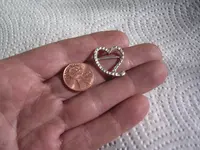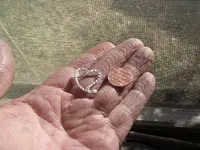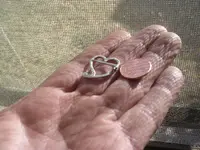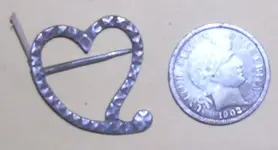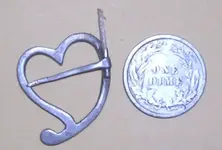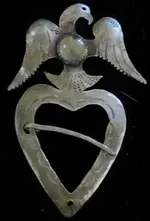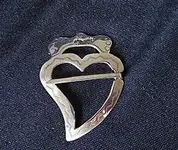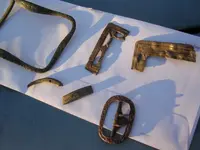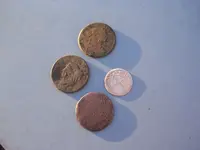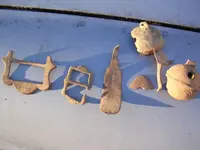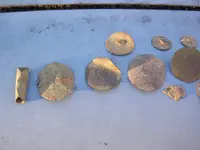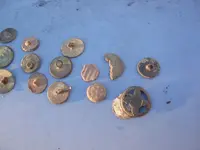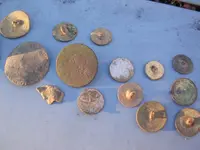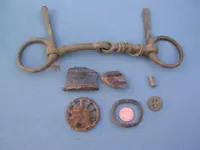CTwoods
Sr. Member
- Joined
- Dec 9, 2015
- Messages
- 315
- Reaction score
- 311
- Golden Thread
- 0
- Location
- east central Connecticut
- Primary Interest:
- Relic Hunting
Colonial Era? Silver Witch's Heart
My favorite find, but have come to a dead end with information, or matches on design. At this point, due to tiny size, I believe this one was used on an infants wrap.
Seems to be a silversmithed piece, and the two ears on the heart body, might be soldered on. The iron hinge pin was frozen with the crossbar in open position, and the pin turned to rust-dust as I tried to free it loose.
Here are some website quotes, but take it for what it's worth:
-Found: 15 years ago
-Where: right alongside the "Connecticut Path" which was the path traveled in 1638 from the Massachusetts Bay Colonies, by Reverend Hooker, leading the first group of English settlers to form new colonies in Windsor and Wethersfield Connecticut. That trail was used for a very long time afterwards, perhaps 150 years. There is lot of web video/info on the Connecticut Path, by one descendant of the Newtons whom had been on the first trip that took 28 days. He does segments showing each section of the path from Newton to central Connecticut. ( I know there is no way to tie this item to an early traveler, or a local resident here)
The wooded spot that this was found, was not good for anything but woodlots, and the only item I ever found in a 1/4 mile radius, was an ox shoe. There never were any homesites on this side of the now-abandoned dirt road. There are two cellars 1/8 mile away in opposite directions, on the other side of the road. This road was certainly still in use by 1900, IMO.
The two smaller pics were taken back then, and were posted on a MD forum; a member from Salem Mass, posted a pic of a silver knee buckle that had the same "pyramid shaped details", and he said it must have been from the same maker. He said his was from "an unknown Boston silversmith" ..for what that is worth. I regret not saving his pic.
I would like to know more about this item, if you care to help with your knowledge. Thanks
My favorite find, but have come to a dead end with information, or matches on design. At this point, due to tiny size, I believe this one was used on an infants wrap.
Seems to be a silversmithed piece, and the two ears on the heart body, might be soldered on. The iron hinge pin was frozen with the crossbar in open position, and the pin turned to rust-dust as I tried to free it loose.
Here are some website quotes, but take it for what it's worth:
The tail of a witch’s heart twists to one side (almost always the right side) and is a shape that has been in use since the 15th century. It gained popularity in Scotland in the 17th century when it became known as a Luckenbooth, named for the closed booths in Edinburgh where they were sold as tokens to ward off evil spirits and protect loved ones. Tiny witch’s hearts were often pinned to a baby’s blanket as protection. By the 18th century, the shape had taken on a slightly different meaning — they were given to a loved one as proof of being “bewitched.” As love tokens, they are most commonly made of garnets. Both examples show crowned hearts, signifying loyalty to the “bewitching” one. The double heart, as seen in the garnet example, generally indicates a committed love relationship, such as betrothal or marriage
Usually an antique luckenbooth brooch is silver and quite small. Silver can be associated with good fortune or protection against evil, in Britain and across Europe. Think of traditional silver christening gifts for babies or silver charms of various kinds.
There were also practical reasons why silver was more popular than gold. Most heart brooches were not showy pieces for the wealthy classes. Silversmiths knew a lot of poorer customers wanted this kind of jewellery. Simple looped pins, not fully hinged, were common fastenings. If the brooch was decorated with gems, they were often coloured glass paste. Semi-precious garnets were also used. Today, even the plainest luckenbooth brooches are sold at antiques auctions for a good price if they were made before 1800.
Luckenbooth brooches used to have other names too.
•Witch’s brooch. This underlines the superstitious reasons for protecting children with a small piece of silver pinned on their clothing.
•Mary’s brooch. Some people say the v-shaped dip in a capital M resembles the the top of a heart, and there are stories linking the brooch with Mary Queen of Scots and her husband Lord Darnley.
-Found: 15 years ago
-Where: right alongside the "Connecticut Path" which was the path traveled in 1638 from the Massachusetts Bay Colonies, by Reverend Hooker, leading the first group of English settlers to form new colonies in Windsor and Wethersfield Connecticut. That trail was used for a very long time afterwards, perhaps 150 years. There is lot of web video/info on the Connecticut Path, by one descendant of the Newtons whom had been on the first trip that took 28 days. He does segments showing each section of the path from Newton to central Connecticut. ( I know there is no way to tie this item to an early traveler, or a local resident here)
The wooded spot that this was found, was not good for anything but woodlots, and the only item I ever found in a 1/4 mile radius, was an ox shoe. There never were any homesites on this side of the now-abandoned dirt road. There are two cellars 1/8 mile away in opposite directions, on the other side of the road. This road was certainly still in use by 1900, IMO.
The two smaller pics were taken back then, and were posted on a MD forum; a member from Salem Mass, posted a pic of a silver knee buckle that had the same "pyramid shaped details", and he said it must have been from the same maker. He said his was from "an unknown Boston silversmith" ..for what that is worth. I regret not saving his pic.
I would like to know more about this item, if you care to help with your knowledge. Thanks
Amazon Forum Fav 👍
Attachments
Upvote
3



